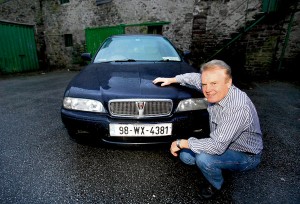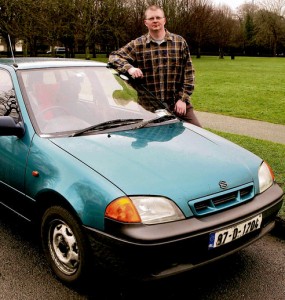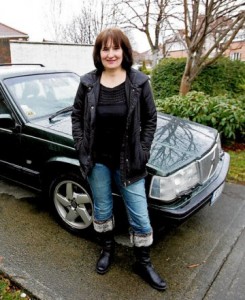
Caption: Fergal Brehony, from Dublin, says getting Kamra is the best thing he’s ever done
Laser surgery for age-related sight defects is proving popular, writes John Cradden
IF YOU have to hold this newspaper at arm’s length, or squint your eyes while reading this on a screen, it could be well worth your while reading on.
A revolutionary new type of laser eye surgery has been introduced into Ireland over the past year that promises a lifelong solution to presbyopia, an age-related condition that affects all of us to some extent as we reach our 40s or older.
Put simply, as the natural lens inside the eye ages, it becomes less flexible, or stiffer, resulting in problems with things like reading words or focusing on objects up close.
Laser eye surgery to fix presbyopia is nothing new, and many older people fed up of fumbling with multiple reading glasses or contact lenses have opted for one of the well-established procedures available to help with the condition.
But the downside with these procedures, which use lasers to reshape the corneas to improve vision, is that any correction for reading vision may have to be done again in later years as the eyes continue to age.
The difference with the new procedure, called Kamra, is that it promises to offer a more permanent and much simpler fix for the condition.
It involves placing a tiny disk with a pin hole in the middle over the cornea.
William Power, a consultant ophthalmic surgeon at Blackrock Clinic, says the principle behind the idea is an age-old one but is well understood by professional photographers.
“Say you’re taking a photograph of a couple in front of you but you want the mountains behind them in focus as well, what you do is you narrow down the aperture, and that increases the range of the depth of focus. That’s the simple principle, and the same applies to Kamra.”
The inlay is also only inserted in one eye — the non-dominant eye that is used for reading.
Fergal Brehony (52) from Rathfarnham in Dublin, says that undergoing the Kamra procedure was “the best thing he has ever done”.
“For the majority of my life I had perfect vision. Then, like everybody else, once I hit around 40, I needed glasses.”
When he heard about Kamra earlier this year while at Blackrock Clinic, he needed little convincing.
“Even in terms of glasses, I am done now. There’s been an incredible benefit. I haven’t picked up my glasses since the day I had surgery.”
There was no pain or discomfort and, less than 24 hours afterwards, he was able to drive himself down to west Cork.
As well as offering a permanent fix to presbyopia, Kamra is also less of a compromise compared to other surgery procedures, according to Dr Arthur Cummings, a consultant ophthalmologist at the Wellington Eye Clinic and UPMC Beacon Hospital.
Conventional laser surgery involves trying to achieve something called monovision, he says, which means “making the one eye better for distance and making the other eye better for near. What the brain does is, it marries that information and keeps everything in focus, far and near.”
However, some people with perfect distance vision, but who need help with near vision, may not be able to cope with monovision (which can be demonstrated in the clinic or through contact lenses).
They often find, for instance, that while their near vision improves, their distance vision is affected.
‘That’s when Kamra makes sense,” says Cummings. “So you place the Kamra inlay into the reading eye, it improves the reading eye, but without the same loss of vision you get from monovision.”
Blackrock Clinic, which started doing Kamra about six months ago, has done the procedure on over 20 patients so far, while the Wellington, which has offered it for a year now, has done nearer 40.
“It’s growing month-on-month significantly,” says Power, who reports that most of his patients are in their 50s.
At Blackrock, over half of the patients have opted for Kamra in conjunction with conventional laser surgery.
“For a certain percentage of people, their distance vision, at that age, is also beginning to fade a little bit too, and what we find is that with a bit of Lasik, we can improve their distance vision and, with that, their near vision with Kamra also works better.”
This is what Chris Smith (52) from Sandymount in Dublin opted for.
He was fed up with years of fumbling around with multiple sets of reading glasses, and his distance vision had also deteriorated.
He says the two procedures together made a huge difference. “I can say that it has transformed my life. When you have to wear glasses, it compromises quality of life.”
Although the Kamra has been used in select clinics in the EU for up to five years, the company that has patented it has stepped up its availability over the past year.
There have been no reported problems with Kamra, although Power understands that it has failed to work for about one in 100 patients to date. But he points out that the procedure is completely reversible with no permanent damage, something that is likely to help its popularity among those squeamish about the risks of conventional laser surgery.
“You’re just back to square one,” he says.
The cost of the procedure alone is about €2,000 depending on the clinic, but the cost is reduced to about €1,000 if you have it along with a conventional laser surgery procedure, such as Lasik.
It’s not covered by health insurers, but you can offset it as a medical expense against your income tax at 20pc.
Both Brehony and Smith say it’s money well spent. Smith says that, in the longer term, he is likely to save money because of the number of times he was having to get new, stronger glasses every year.
“Apart from that, the improvement in the quality of life is the main thing.”
This article first appeared in the Irish Independent








Overparenting
A US psychologist is urging parents to chill out and just let their children get on with things, writes John Cradden
Monday September 17 2012
PUSHY parents, eh? Look at their poor kids. You can almost see the deadness in their eyes. Being shuttled from one activity to another in the SUVs, seven days a week. Get a life.
Mind you, you have to wonder at the energy that drives these outwardly successful helicopter parents.
It must be exhausting, both managing a successful career and micro-managing their kids to ensure they get the best possible advantage in this dog-eat-dog, recession-riddled world.
My attitude couldn’t be more different. I can’t be bothered spending every afternoon ferrying them from music class to maths grinds and from gymnastics to GAA.
“Can I go out and play?” asks my five-year-old daughter. “No, it’s too dangerous out there, you might get run over.”
“Will you play a game with me then?” “No, I’m too busy, love”, I say, before handing her the iPad to play with.
I think I fall into a category of my own: the ‘lazy-but-overprotective parent’.
So when I stumble across an interview with US psychologist Madeline Levine about her new book, which supposedly advocates an approach termed ‘underparenting’, I’m hooked.
Here are some of the tips from her book, entitled ‘Teach Your Children Well’.
* Don’t be your children’s entertainment director (boredom forces children to make their own entertainment). Check.
* Don’t stop sibling squabbles (they’ll learn about compromise, survival and the art of negotiation). Check.
* Lose the buggy at age three (helps with exercise and communication). Our two-year-old insists on walking most of the time herself anyway, so er … check.
Levine’s previous book, ‘The Price of Privilege’, was a huge bestseller in the US. It explored why teenagers from affluent families were experiencing high rates of emotional problems, limited coping skills and disengagement from learning.
She found that it was mainly due to parents who had geared almost all their children’s lives to achieving high grades, trophies and entry into top schools and universities.
It turns out that the phenomenon is not confined to rich families but also huge swathes of middle-class households.
So the new book is an attempt to offer practical advice to parents who feel they want to change their approach in order to help their kids learn “real-world” skills that are important for success, including creativity, innovative thinking, resilience in response to failures, communication skills and the ability to collaborate.
It’s an interesting read and makes lots of salient points in a country where many parents are unhealthily obsessed with Leaving Cert points and the whole CAO merry-go-round.
Anne Conroy, training and resource service manager at children’s charity Barnados, says Ireland certainly has plenty of hyperactive parents.
“Research, which has included Irish research, has found that their over-involvement in such activities tends to cancel out the learning benefits of taking part in them.”
But she adds that there is no one way to parent.
“Every child and every family is unique, with its own background and its own way of doing things. Some of what Levine is promoting is helpful.”
When I interview Dr Levine I ask her if she really is suggesting that parents should become lazier in their approach in order to produce more rounded children.
She is livid with one newspaper’s suggestion that she’s all about ‘under-parenting’.
“I hated that article! They called it underparenting. As soon as I have time to breathe I need to write them a letter.
“The opposite of helicopter parenting or pushy parenting, or whatever, is not underparenting, it’s appropriate parenting,” she explains.
“It’s not that kids don’t need to be parented, they absolutely do. My suggestion is that instead of spending 95pc of our effort on what grades our kids get, or what college they are going to, that we pay some attention to the other aspects of character and coping skills that we know are necessary if you are going to have a reasonably successful life.”
Parents often do so much to ‘help’ their children that they end up doing more harm than good.
“It’s an exhausting cycle of constantly monitoring their performance, which in turn makes them feel less competent and confident, so that they need even more overseeing.”
Levine says she is acutely aware of just how fast things are evolving in terms of what kids are learning simply because the world itself is changing so fast, so the need to learn better coping skills, for instance, becomes all the more important.
But before they try to change their approach, parents need to think about themselves first, she says.
“The first thing I would say to parents is to make sure that their own lives are in order.
“I think a lot of this hyper vigilance around kids has to do with parents feeling that they themselves are under tremendous scrutiny, or a lot of peer pressure.”
She suggests that parents get a hobby. “Make sure not everything you do is centred around your child,” she says.
“I can’t tell you how many kids have said in my office, ‘please tell my mother to get a hobby besides me.'”
She also suggests that parents learn to tolerate some distress in their kids.
“My advice always is, if you can’t stand to see your kid unhappy, you are in the wrong business.
“Part of developing resilience is making it through challenging things in life. And if you are always stepping in for your kid, they don’t get to do it.”
Even for those of us who are not so inclined to over-parent, Levine’s book offers useful reminders of just how important things like family time and unstructured outdoor play are, which can often be impinged upon by technology as much as too many extra curricular activities.
(Note to self: lock the iPad away.)
Margaret Harrington, a 46-year old mother of three teenage children aged 17, 15 and 11, says much of the practical advice in Levine’s book does make sense.
“I am a strong believer in teaching kids proper life skills,” says Harrington, from Carlow.
“This extends not just to my own kids, but anyone who visits here.”
Such skills include cooking and baking healthy food, doing laundry, ironing a school uniform, wiring a plug, basic food hygiene, working the central heating and fixing leaky taps. The list is endless, really.
“They will need to be resourceful when they grow up. Kid-glove parenting is the opposite of this.”
Being such a busy house means a big effort to sit down for dinner together in the evening is made.
“It makes an enormous difference to communication within the family. Everyone gets to share their day’s events, no matter how mundane.
“It means everyone’s talking, which, in this day and age, is not a given any more.”
Planned activities are minimal.
“The eldest plays saxophone and does karate. Our son plays GAA and rugby. The youngest girl does modern dance. That’s it.
“The kids get everything they need, but they are not molly-coddled in any way. I think that is a good thing.”
– John Cradden
Originally published in the Irish Independent